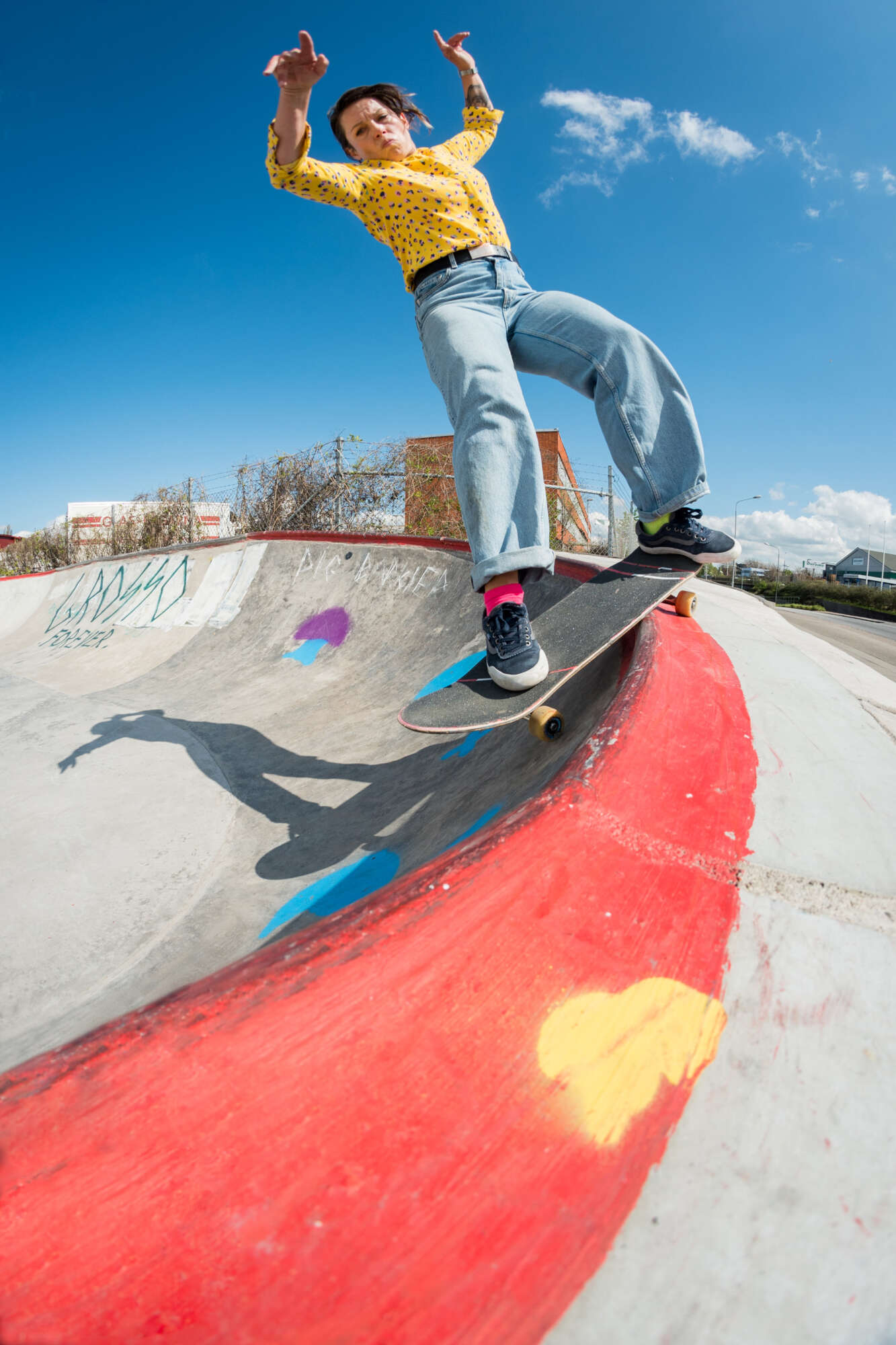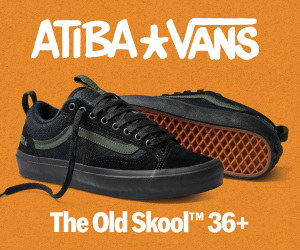They are intricate, compassionate renderings of concrete, tile, ply and patina, drawn by a soul who knows the significance of the spaces within. There’s also a noticeable New Zealand thread to her body of work.

Lorna Goldfinch, frontside Smith grind. Photo by Jacob Hansson.
You come and go from Aotearoa. What is your connection to NZ, and where else do you call home?
All of my family — mum, dad and brother — moved to Aotearoa in the late 1990s, but I kept my base in the UK and Europe instead of following. It has only been in the past seven years or so that I have felt a call to come over on a much more regular basis. I made some changes that meant I could follow the sun, living in a more light-footed way. I now move between Cornwall, England, Malmö, Sweden and Auckland, Aotearoa, on a bit of a cycle.

Steppeside, Malmō, Sweden.
How did you settle on the style and subject matter of your work?
I think that style organically grows from the combination of personality and practicality for an artist. I trained as a photorealistic painter when I was twenty, but as a person, I have bursts of intense focus and struggle to keep the life in my work if I return to the same painting over and over. When I am painting, it is very much in a flow state where my chatterbox mind is totally quiet, just like skating, just like meditation, so each piece is a single episode of this state from start to finish.
I also love following a theme and seeing where it takes me. I followed graffiti and street art around the world for a year and documented that — I enjoyed the painter trying to understand the painter’s aspect. Once that project was completed, I was on a skate trip in Barcelona with my best friends from Malmö and injured my knee on the second day. To still feel part of the sessions, I just got my sketchbook out and started painting the spots we were skating. It worked beautifully. It usually takes around two hours for a painting, and by the time I was finished, everyone was warmed up enough for me to shoot their tricks. I just kept filling sketchbook after sketchbook with these paintings once we returned to Malmö.
“Seeing what kind of objects the crew added to the park the night before. It always warms my heart. They’re so active at keeping that park alive.”

Potato Banks, Auckland, New Zealand.
Can you explain your process and the tools you use?
Whilst I am still transiting between the three parts of the world, I am documenting everything in sketchbooks. I prime the paper with a base of bright matt-acrylic, but all I take out is a very limited palette of cyan, magenta, yellow, white and a dark purple gouache from which I mix all of the colours in my work. [I use] a few flat paintbrushes and a coloured pencil for drawing.
Whenever I have a home base for a longer period, I hire a studio and work on larger scale work. It’s been a while since I last sat still, so I am not sure how my larger works will evolve next.
I used to work in pen and watercolour in my studio on meter-wide sheets of watercolour paper. I now have huge folders in my friend’s basements, waiting for me to pick somewhere to live so I can consolidate everything in one location. Something about having all that stuff just feels like a bit of a weight right now. The sketchbooks can come along with me, and if I get homesick for a different life, I can just flick through them.

Pig Barrier DIY, Malmō, Sweden.
Spots come and go. How important to you is it to document these spaces?
There is something fascinating to me about the passing of time, of change, of impermanence in the physical environment, especially the hard concrete urban environment. We build these structures from such dense materials — stone, concrete — and yet, with enough time, even raindrops and weeds can turn them to dust if they are not nurtured. It’s a beautiful dance. I have so much respect for everyone who puts effort into building or repurposing something, knowing it won’t last.
The act of sitting in a space and painting it is one of really and truly seeing it as it is during that little window of its lifespan. It’s different from photography. I can take a photograph and still not really look at every rock or crack in the concrete. To paint it is to know it.
It’s not always so serious, though. One of my favourite activities when I live in Auckland is driving down to BSP (Birkenhead Skate Park) in the morning and seeing what kind of objects the crew added to the park the night before. It always warms my heart. They’re so active at keeping that park alive.

Birkenhead Skatepark (BSP), Auckland, New Zealand.
Is there a spot or park you’ve drawn that is particularly close to your heart?
The spot closest to my heart would have to be the Boobs Bowl in Malmö — a bowl hidden in a tiny bit of woodland that was kept such a tight secret that very few people ever skated it. I still like to think that it found me instead of the other way around, as it was so unlikely that I would have discovered it otherwise. It was demolished not long after I painted it, but I still make sure I go back to that patch of land every time I return to Sweden. I’m sentimental like that.
The second on my list is Pig Barrier, also in Malmö, because I helped build that one with my friends, so I truly got to experience how much work and passion goes into creating these places. On one of the first build days, we were all sitting around after hand mixing concrete for hours on a Sunday morning, passing a bottle of red wine between us (the main crew building Pig are French), eating sausages off the grill. The sound of the church choir next door drifted through the air to do battle with the punk from our speaker. Here we were, a group of waifs and strays building something together just for the love of it. It felt like home.

Boobs Bowl, Malmō, Sweden (RIP).
Skate spots or parks, especially DIY ones, are expressions of the skaters that form them. How do you think these spaces define who we are as skateboarders?
I absolutely feel that the places that skaters choose to skate and build are a reflection of the skate culture present at the time. A response and a reaction to it. I mean, why would there even be DIY spots in cities where there are so many world-class skateparks if it wasn’t a reflection of some people’s need for autonomy? I really love people, and I love understanding them as individuals and also as collectives. Yet to me, the spaces will always have their own soul that includes but is not exclusively, an amalgamation of the personalities that built and skated them. There is something else present in them that I just love being around. There are also the marks left by skaters that I enjoy seeing around a city — a bit of wax on a ledge, the telltale wall ride arcs. It’s like being in a secret club with its own language written everywhere. It makes the urban environment feel less anonymous and hostile.
Your work is as much about preservation as it is about artistic expression. Is that the reading you’re angling for?
Yes. In a world that contains Social Media, it can be overwhelming for artists to feel like there is any point in creating anything at all. I don’t follow many artists on Social Media for this exact reason. The only way I could find to get around this ‘pointless’ feeling was to dig deeper into the things that are specifically of interest to me and document them — to place a little spotlight on these special places scattered around the world.
I have been told that the paintings I make are ’prettier than the actual environment’, but I don’t try to beautify anything artificially. I just sit down and paint how it looks through my eyes.

Paral-lel, Barcelona, Spain.
Are there spots you haven’t yet documented on your bucket list?
There are a few quests I am hoping to schedule in — a little road trip across Europe from spot to spot all the way down and across to Taghazout, Morocco. I also love DIY spots hidden in forests or jungles, which might form the core of an upcoming mission. And, of course, the backyard pools in the States would be my absolute dream come true. That will keep me busy for a bit.
Follow Lorna on Instagram @lornastration.
This article was first published in Manual, Issue 70, April 2023.


